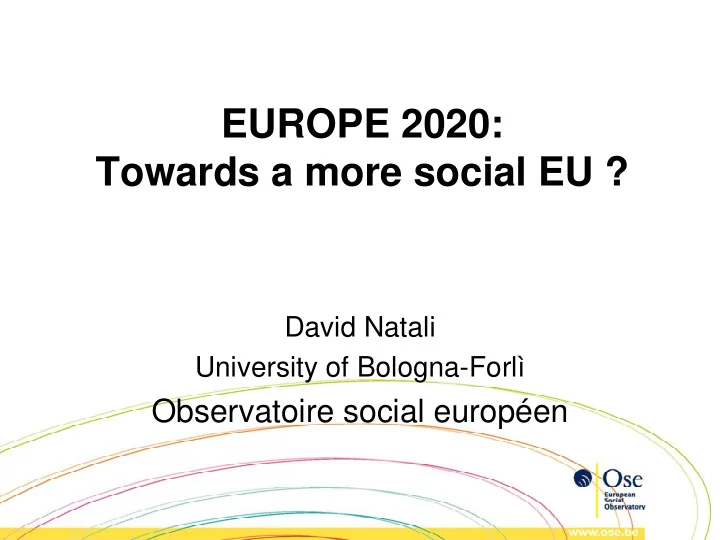

EUROPE 2020: Towards a more social EU ? David Natali University of Bologna-Forlì Observatoire social européen
Europe 2020, The Book E. Marlier and D. Natali (eds.) with R. VanDam (2010), ‘Europe 2020: Towards a more social EU?’, Brussels, PIE-Peter Lang.
EUROPE 2020, The Presentation • WHY ? • WHAT KIND OF STRATEGY ? • WHAT OPPORTUNITY/RISK FOR THE FUTURE OF THE EU (and its social dimension) ?
1. WHY EUROPE 2020 ? • Second Social Question in Europe (M. Ferrera) • Social rights and their definition at national level (19 th and 20 th Century) • EU integration, ‘Keynes at home, Smith abroad’ • Need for a re-articulation
1. WHY EUROPE 2020 ? • Need for mutual recognition and concessions • Charter of Fundamental Rights, ECJ rulings (Lavall, Viking, Rueffert) • Need for a Happy Marriage between eco. Integration and social solidarity • Because of the ESM • Because social policy as a productive factor • Because of EU legitimacy to be improved
2. WHAT STRATEGY ? The content, “to turn the EU into a smart, sustainable and inclusive economy delivering high levels of employment, productivity and social cohesion. (…) This is an agenda for all Member States, taking into account different needs, different starting points and national specificities so as to promote growth for all.”
2. WHAT STRATEGY ? The governance: the integrated pillars, 1. Macro-economic surveillance , which aims at ensuring a stable macro-economic environment conducive to growth and employment creation; 2. Thematic coordination, whose focus is on structural reforms in the fields of innovation and R&D, resource- efficiency, business environment, employment, education and social inclusion; 3. Fiscal surveillance under the Stability and Growth Pact , which should contribute to strengthening fiscal consolidation and fostering sustainable public finances
2. WHAT STRATEGY ? What is new… 1. in Europe 2020 I. Ten Integrated Guidelines II. Seven Flagships III. More Coordinated Governance (EU Semester) and more stringent coordination 2. in the EU Institutional Context , The Lisbon Treaty I. Horizontal Social Clause (Art. 9) II. Charter of Fundamental Social Rights III. Social Security Emergency Break (Art. 48) IV. Services of General Interest (Protocol 26)
2. WHAT STRATEGY ? What is new… 3. in Europe and in the EU political context I. The new political context (right-of-centre dominance) II. The new economic context, Aftershocks III. The new Institutional context (ECOFIN dominance)
3. WHAT RISKS AND OPPORTUNITIES? The opportunities… • New balance between social, economic and employment goals • New tools, Flagships and key headline target on poverty • Stronger thematic coordination (possibility for recommendations on social policies) • The new institutional context (Treaty of Lisbon)
3. WHAT RISKS AND OPPORTUNITIES? The opportunities… • Mainstreaming social objectives • Social Impact Assessment • Mobilisation of EU cohesion policy (territorialisation of social policy) • The new institutional context (Treaty of Lisbon)
3. WHAT RISKS AND OPPORTUNITIES ? The risks… a) ABOUT THE PARADIGM • Marginalisation of the social side of the story (due to the crisis) • Uni-dimensional social policy (focus on poverty) • Timing (economic crisis much more fast than social coordination), ECOFIN domination • Internal incoherence (structural reforms vs. fiscal stability)
3. WHAT RISKS AND OPPORTUNITIES ? The risks… a) ABOUT THE GOVERNANCE • Limited visibility • Limited political appropriation/participation • Limited activation of the institutional capabilities at EU and national level • From multi-lateral to bi-lateral coordination (OECD +)
OPPORTUNITIES ? The risks… 3. WHAT RISKS AND
4. Conclusion 1. Lisbon Treaty and Europe 2020 may represent an opportunity 2. But political context is unfavourable 3. What strategy for the future? I. Compromise or Conflict
Recommend
More recommend